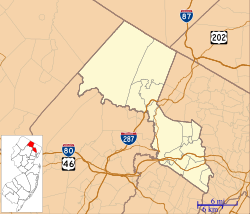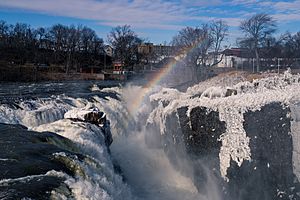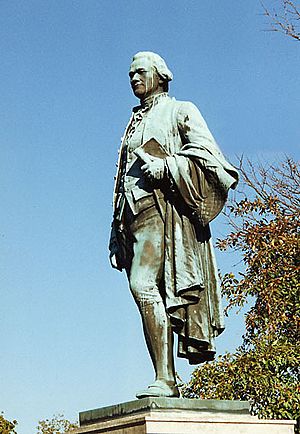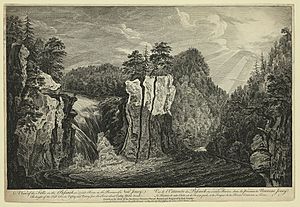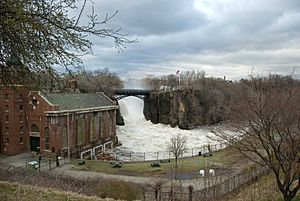Great Falls (Passaic River) facts for kids
|
Paterson Great Falls
National Historical Park |
|
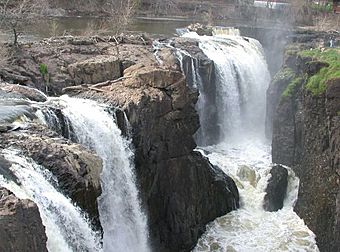
The Great Falls of the Passaic River.
|
|
| Location | Paterson, New Jersey |
|---|---|
| Website | Paterson Great Falls National Historical Park |
| NRHP reference No. | 86001507 |
Quick facts for kids Significant dates |
|
| Added to NRHP | August 14, 1986 |
| Designated NHLD | May 11, 1976 |
| Designated NHP | November 7, 2011 |
The Great Falls of the Passaic River is a huge waterfall in Paterson, New Jersey. It's about 77 feet (23 m) high! This amazing natural wonder and the land around it are now protected as the Paterson Great Falls National Historical Park. The National Park Service takes care of it.
This waterfall is one of the largest in the United States. It played a super important role in how New Jersey grew into an industrial powerhouse. The area is also known as the Great Falls of Paterson–Garret Mountain National Natural Landmark. It's even a National Historic Landmark District because of its special history. The systems that used the falls' power were recognized as a Historic Civil Engineering Landmark in 1977.
Contents
Discovering the Great Falls' Past
How the Falls Were Formed
The Great Falls were created by nature about 13,000 years ago. This happened at the end of the last ice age. Before that, the Passaic River flowed a different way. But a huge glacier blocked its path.
A big lake, called Glacial Lake Passaic, formed behind the mountains. As the ice melted, the river found a new path. It carved its way through hard rock called basalt, forming the falls we see today. This basalt rock is super old, about 200 million years old!
Long ago, Lenape Native Americans lived near the falls. Later, in the 1690s, Dutch settlers also made their homes here.
The Falls and Early Industry
In 1778, a very important person named Alexander Hamilton visited the falls. He was amazed by how much power the waterfall could provide for factories. Later, when Hamilton was the nation's Secretary of Treasury, he chose this spot for America's first planned industrial city. He called it a "national manufactory."
In 1791, Hamilton helped start a group called the Society for the Establishment of Useful Manufactures (S.U.M.). This group wanted to make his vision come true. The city of Paterson was founded by this society. It was named after New Jersey Governor William Paterson, who supported their efforts.
Hamilton asked Pierre Charles L'Enfant, who designed Washington, D.C., to plan the city's water system. This system included raceways, which were like canals. They carried water from the falls to power watermills in the new town. Because of this, Paterson became a major center for mills and factories.
In 1792, the first water-powered cotton spinning mill in New Jersey was built here. Later, in 1812, the state's first continuous roll paper mill opened. Many other important things were made using the falls' power. These included Rogers Locomotive Works (trains) in 1832, the Colt revolver (guns) in 1837, and even the USS Holland (SS-1) (a submarine) in 1898. The Phoenix Mill, built in 1813, is the oldest building still standing in the historic area.
The factories here also became a place where workers fought for better conditions. In 1913, many immigrant workers went on strike because they faced tough conditions. This helped start the first organized labor movement in the United States.
The S.U.M. group continued to operate until 1945. Then, the city of Paterson bought its land and rights. Over time, many industries in the area closed down. In 1971, a new group was formed to help restore the old mill buildings and raceways.
Visiting the Great Falls Today
You can see the Great Falls from a few great spots! There's Haines Overlook Park on the south side and Mary Ellen Kramer Park on the north. You can also drive by on McBride Avenue, which crosses the river right above the falls.
A special footbridge goes over the gorge of the falls. This bridge is also a fantastic place to get a good view. There's a visitor's center nearby where you can learn all about the falls. It tells the story of Paterson's industrial and cultural past. In 2016, a record 177,000 people came to see the Great Falls!
A National Natural Landmark
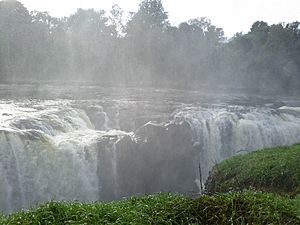
The Great Falls of Paterson – Garret Mountain area was named a National Natural Landmark in 1967. This means it's a special place that shows how the Earth's geology works. The area helps us understand how basaltic lava flow shaped the land millions of years ago.
Being a National Natural Landmark helps protect the site from certain types of development. People in the community have worked hard to protect the historic character of the area. They want to make sure the falls and its history are preserved for everyone.
Becoming a National Historical Park
The Paterson Great Falls National Historical Park officially joined the National Park System of the United States. On March 30, 2009, President Obama signed a law to make the falls a national historical park. This gives the 77-foot waterfall even more federal protection.
By 2011, the land around the falls was given to the federal government. This allowed the new park to be created. On November 7, 2011, Secretary of the Interior Ken Salazar officially accepted the land. He dedicated the park as the 397th unit in the nation's park system.
Making Electricity from the Falls
The Great Falls also has a hydroelectric plant. This plant uses the power of the falling water to create electricity. It's operated by a company called Eagle Creek Renewable Energy.
The plant has three special machines called Kaplan turbines. They can produce a lot of electricity, about 10.95 megawatts. Water flows through huge pipes, called penstocks, to spin these turbines. This process helps power homes and businesses using clean energy from the river.
Images for kids


